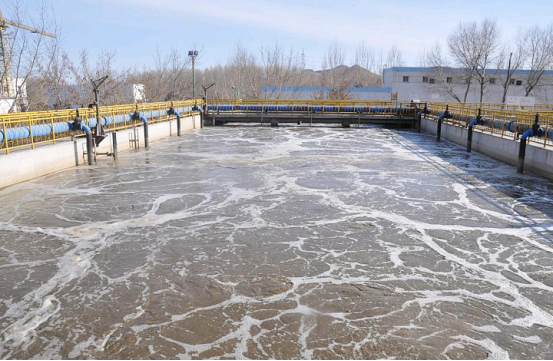Recently, colleagues have reported that their wastewater treatment systems have started experiencing bulking again. This happens every year and is very cyclical! In fact, many wastewater treatment systems don't experience severe sludge bulking during the hot summer or cold winter, but it often occurs during the seasonal transitions of spring-to-summer and autumn-to-winter. That is, it happens in environments where temperature, water temperature, and air pressure are changing.
After analyzing statistical data from some wastewater treatment plants, the periods when foaming phenomena occur are: when the system transitions from water temperature being higher than air temperature to water temperature being lower than air temperature (March to April), and when it transitions from water temperature being lower than air temperature to water temperature being higher than air temperature (October to November).
1. Analysis of Causes for Seasonal Bulking
Due to changes in the ecological environment, the growth and composition of microorganisms undergo changes. From past operational experience, it's been observed that without changing other conditions, the foaming phenomenon gradually disappears (within 10-20 days) and the wastewater treatment system repairs itself.
Microscopic examination reveals that during the spring-to-summer transition, the foam is primarily caused by an outbreak of filamentous bacteria, which grow in large quantities and extend outwards. During the autumn-to-winter transition, the foam is formed from floating sludge where inactive filamentous bacteria are enveloped within equally inactive floc-forming bacteria.
The exact principle still requires further research. Generally, it's believed that when seasons change (temperature, air pressure), all microorganisms are affected. However, filamentous bacteria adapt better than some floc-forming bacteria. For example, Microthrix parvicella can grow between 8-35°C and is more suited to low-temperature environments.
When the environment is unfavorable for microbial growth, the filaments of filamentous bacteria extend out from the flocs to increase their surface area for nutrient uptake, growing faster than other microorganisms.

During the spring-to-summer transition, the activity of the sludge generally decreases. Synthetic detergents and oils/fats in the influent sewage are not adequately degraded, while some filamentous bacteria remain active. These bacteria thrive on these substances as food and multiply rapidly, leading to an outbreak of filamentous bacteria and foam formation.
During the autumn-to-winter transition, floating sludge primarily forms (which differs from the previous case). Extended filamentous bacteria are rarely found in this floating sludge and foam. Microscopy shows the floating sludge contains trapped fine air bubbles. It's estimated that during this environmental transition, the flocs become dispersed and finer, and their density decreases after combining with air bubbles, causing them to float.
2. Control Methods for Seasonal Bulking
Understanding the pattern of foam formation is beneficial for implementing control measures.
For Spring-to-Summer Transition Foam: Mechanical removal or skimming methods are used. Because this foam contains large amounts of filamentous bacteria, it should not be left in the mixed liquor to avoid re-causing the foam. Disposal methods are as described later.
For Autumn-to-Winter Transition Floating Sludge and Foam: High-pressure water jets can be used to break it up and alleviate the problem. This is because the floating sludge still consists mostly of floc-forming bacteria, which can return to the mixed liquor after being broken up.
3. General Bulking Control Methods (Applicable especially where filamentous bacteria are dominant)
1. Adding Coagulants
Adding synthetic organic polymers, iron salts, or aluminum salts as coagulants can increase sludge density and compactness through flocculation. Adding substances like kaolin, calcium carbonate, or calcium hydroxide can also improve sludge settling performance by increasing its compactness. Practice shows that plants without primary sedimentation tanks generally have lower SVI values. Therefore, for plants with primary tanks experiencing sludge bulking, diverting a portion of the raw sewage directly to the aeration tank is also a control method.
2. Adding Cl2 or Bleaching Powder
Chlorine (Cl2) is the traditional oxidizing agent used to control sludge bulking. The oxidizing agents Cl2, HOCl (hypochlorous acid), and OCl- (hypochlorite) penetrate cells and destroy enzymes, leading to cell death. Most types of filamentous bacteria can be controlled by chlorination.
This is typically dosed into the return sludge. Dosage is critical: overdosing can kill off normal floc-forming bacteria, while underdosing may be ineffective and worsen effluent quality. The optimal dosage of bleaching powder (or Cl2) is determined by testing different dosing ratios and observing the inhibition of activated sludge, primarily through microscopic examination of protozoa/metazoa activity and quantity, and the degree of damage to filamentous bacteria. As the SVI decreases and bulking subsides, the dosage should be gradually reduced.
3. Introducing Inert Substances to Suppress Filamentous Bulking
We have found in practice that highly or extremely expanded filamentous bacteria are difficult to effectively stop with simple methods. However, adding inert substances can suppress filamentous bulking. A sufficient amount of inert material entering the biological system enhances the relative settling performance of the activated sludge while also disrupting the structure of the filamentous bacteria, reducing their degree of expansion and slowing their reproduction rate. Therefore, introducing inert substances has a significant inhibitory effect on filamentous bacteria.
4. Adjusting pH to Suppress Filamentous Bulking
Using wastewater with a high pH to suppress filamentous bulking. Because filamentous bacteria have a larger specific surface area than floc-forming bacteria, they are theoretically more vulnerable overall to acute environmental deterioration, especially tolerance to high pH and toxic substances inhibitory to activated sludge. However, the pH control range is crucial. Based on experience, maintaining the entire aeration tank at a pH around 10 for 4-8 hours can significantly kill filamentous bacteria. A pH that is too high affects activated sludge negatively, and a pH that is too low is ineffective.



